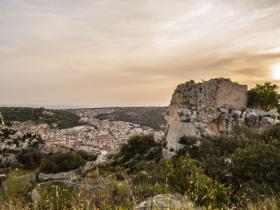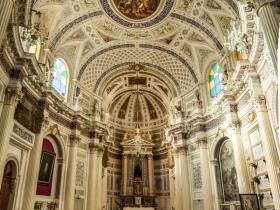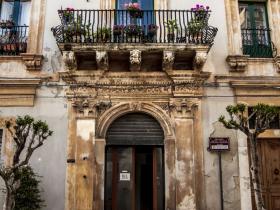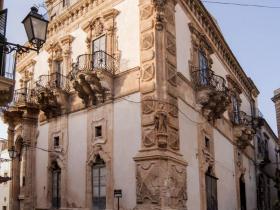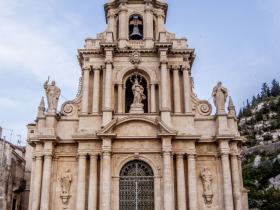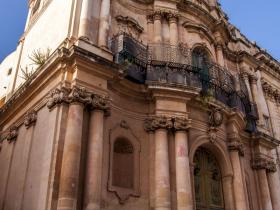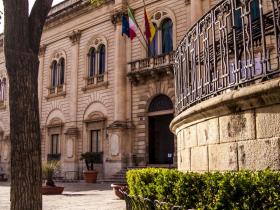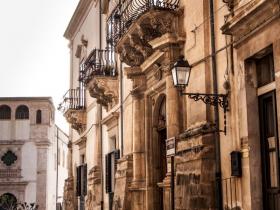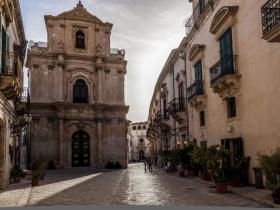B&B Terrazza dei Sogni - Ragusa Ibla
Scicli
City of Scicli
Located between three valleys (Val di Modica, Santa Maria la Nova e San Bartolomeo) grows the fabulous baroque pearl, Scicli, which count just 25.000 habitants. Like Ragusa and Modica, it has the privilege to be patrimony of the UNESCO. The origins of the name are not clear: most probably it comes from the nickname of Siclis which was given by the ancient Siculi. However, some people attribute the name to Casmene, which was one of the sub-colony of Syracuse.
WHAT TO SEE
Chiesa di San Matteo: symbol of Scicli and mother church until the 1874, is located on the San Matteo hill. This church is the oldest religious building of the city. Unfortunately antique architectures that could have established the exact period of the foundation, are hidden and remade several times after the earthquakes. However, some old documents passed on through writers of that time, proved that the church was there in the 313, when the Christianity started to be spread. From San Matteo’s church is possible to admire a fantastic view of the whole city immerse between the valleys.
Chiesa di San Giovanni Evangelista: located next to the town hall, had been founded before the 14th century but destroyed with the earthquake of the 1693 was rebuilt in the second half of the 18th century. The main prospect is divided in three parts and the two couple of columns evidence the central part of the prospect which is convex but the other two parts on the sides are concave. The inside has an oval shape and is characterized by a neoclassic style. On the sides between the columns there are four altars. The vault is very decorated with golden plasters. Next to the sacristy, there is the most important painting of Scicli (made in the 17th centuty) called “Christ of Burgos” which probably has Spanish origins. In this representation, crucified Christ wears a priestly skirt which is really rare in Italy.
Chiesa di San Bartolomeo Apostolo: located in a unique scenery of rare beauty, on the canyon of Saint Bartolomeo. The façade made at the beginning of the 19th century reminds other works (San Giorgio or San Giuseppe at Ragusa Ibla) of Rosario Gagliardi. The inside, mainly in baroque and rococo style, is made with a unique nave.
Chiesa di Santa Maria la Nova: this church has very old origins, most probably byzantine, located on the namesake canyon. The principal prospect is divided in three orders. In the first order there is the important gate which is framed with ionic capitals. In the second order there is a central big window adorned with the same style of the main gate. The third order ends with the tower bell decorated garlands and balustrades of local stone. The neoclassic inside is all made after the catastrophic earthquake of the 1693.
Piazza Italia: this is the main square of the city, surrounded by fantastic buildings. In one side of the square, rise the calcareous cliff where stands the church of Saint Matteo. In another side of the square easy to identified is the church Matrice dedicated to Saint Ignazio. In front of this church there is Palazzo Fava which prospect is characterized with a baroque decorated gate. Also the balconies are richly adorned representing two griffons and two horses with wings.
Palazzo Beneventano: is defined by Sir Anthony Blunt as the most beautiful baroque palace of Sicily. The round railing balconies are supported by fabulous sculptures representing fantastic animals. But in the windows are represented masks and human caricatures. On top of those there is represented the emblem of Beneventano’s family decorated with two dark heads, becoming one of the symbol of the city.
Town Hall: realized between 1902 to 1906is located just beside the church of San Giovanni Evangelista.
Although this is the unique civil palace located in a religious area, it does not give a strange impact. During the last few years this building has got more importance thankfully to the fiction “Inspector Montalbano” which filmed often this location.
Palazzo Spadaro: this palace was owned by Spadaro’s Family originally from Modica but moved to Scicli in the 17th century. The building was constructed in few times during the 1700. In the prospect there are eight rococo balconies with wrought-iron railings. The main gate is richly adorned and is shown the emblem of the Family Spadaro, a lion.
Museum of dresses: in order to discover this epoch and understand traditions of this fantastic land, is worth to visit this museum. Old dresses, suits, hates, other accessories and fashion magazines are shown to public.
Typical restaurants - Trattorie
"Gli Aromi" farm has been producing and marketing about 200 types of medicinal and aromatic herbs of the "Iblei" for several years. The plant of Caper, as they say, is their best strenght which represents a deep connection with this land.
We suggest visiting this interesting place as often small event of all kind are organized. From 2018 the Town Hall of Scicli has recognized them the possibility to celebrate civil weddings.
Il Gioia
Gioia meas happiness and it is attributed to the Risen Christ. This is the most known religious event of Scicli. The day of Easter the statue called "L'uomo vivo" (Alive Man) is brought around the city through songs and dances until late night. The 18th century statue is made of wood and is kept in the church of Santa Maria la Nova. In 2006 a famous singer, Vinicio Capossela, dedicated a song to this party etitled l'Uomo Vivo.
The cavalcade of San Giuseppe
In March a pictoresque ride of horses and knights is the protagonist of the neighborhoods of Scicli led by San Giuseppe and the Virgin Mary. For the occasion bonfires are lit on the side of the streets to create atmosphere. The event represent the travel to Egypt of Giuseppe and Maria after the edict of Herod. At the end of the parade the most beautiful decored riders are rewarded.
Cuttlefish festival
it takes place in Donnalucata in March at the same time of San Giuseppe festivities. Among the stands on the streets many typical plates of Scicli are prepared. Choose your favourite one!
Taranta Sicily Fest
This falk music festival takes place in August with the goal of promoting cultural, theatrical and artistic initiatives. Famous artists are often performing. Good music is guaranteed!
Chiesa di San Giovanni Evangelista: located next to the town hall, had been founded before the 14th century but destroyed with the earthquake of the 1693 was rebuilt in the second half of the 18th century. The main prospect is divided in three parts and the two couple of columns evidence the central part of the prospect which is convex but the other two parts on the sides are concave. The inside has an oval shape and is characterized by a neoclassic style. On the sides between the columns there are four altars. The vault is very decorated with golden plasters. Next to the sacristy, there is the most important painting of Scicli (made in the 17th centuty) called “Christ of Burgos” which probably has Spanish origins. In this representation, crucified Christ wears a priestly skirt which is really rare in Italy.
Chiesa di San Bartolomeo Apostolo: located in a unique scenery of rare beauty, on the canyon of Saint Bartolomeo. The façade made at the beginning of the 19th century reminds other works (San Giorgio or San Giuseppe at Ragusa Ibla) of Rosario Gagliardi. The inside, mainly in baroque and rococo style, is made with a unique nave.
Chiesa di Santa Maria la Nova: this church has very old origins, most probably byzantine, located on the namesake canyon. The principal prospect is divided in three orders. In the first order there is the important gate which is framed with ionic capitals. In the second order there is a central big window adorned with the same style of the main gate. The third order ends with the tower bell decorated garlands and balustrades of local stone. The neoclassic inside is all made after the catastrophic earthquake of the 1693.
Piazza Italia: this is the main square of the city, surrounded by fantastic buildings. In one side of the square, rise the calcareous cliff where stands the church of Saint Matteo. In another side of the square easy to identified is the church Matrice dedicated to Saint Ignazio. In front of this church there is Palazzo Fava which prospect is characterized with a baroque decorated gate. Also the balconies are richly adorned representing two griffons and two horses with wings.
Palazzo Beneventano: is defined by Sir Anthony Blunt as the most beautiful baroque palace of Sicily. The round railing balconies are supported by fabulous sculptures representing fantastic animals. But in the windows are represented masks and human caricatures. On top of those there is represented the emblem of Beneventano’s family decorated with two dark heads, becoming one of the symbol of the city.
Town Hall: realized between 1902 to 1906is located just beside the church of San Giovanni Evangelista.
Although this is the unique civil palace located in a religious area, it does not give a strange impact. During the last few years this building has got more importance thankfully to the fiction “Inspector Montalbano” which filmed often this location.
Palazzo Spadaro: this palace was owned by Spadaro’s Family originally from Modica but moved to Scicli in the 17th century. The building was constructed in few times during the 1700. In the prospect there are eight rococo balconies with wrought-iron railings. The main gate is richly adorned and is shown the emblem of the Family Spadaro, a lion.
Museum of dresses: in order to discover this epoch and understand traditions of this fantastic land, is worth to visit this museum. Old dresses, suits, hates, other accessories and fashion magazines are shown to public.
WHERE TO EAT
Typical restaurants - Trattorie
- Baqqala - 0932 931028 - Piazza Angelo Ficili 3
- Moscabianca (pizzeria) - 0932 841938 - www.moscabianca.business.site - Corso Mazzini 36
- Busacca ristorante (pizzeria) - 392 0665613 - www.busaccascicli.it - Piazza Busacca 1
- Osteria Tre Colli - 0932 931605 - www.osteriatrecolli.com - Piazza Italia 14
- Quore Matto (pizzeria) - 0932 841044 - www.ristorantequorematto.com - Via Mormino Penna 241
- Pura Follia (pizzeria) - 339 8476585 - Via Nazionale 92
- Al Galù - 0932 841249 - www.algalu.it - Via Pluchinotta 2
- Gli Aromi - 342 0616781 - www.gliaromi.it - Contrada Santa Rosalia
EXPERIENCE
"Gli Aromi" farm has been producing and marketing about 200 types of medicinal and aromatic herbs of the "Iblei" for several years. The plant of Caper, as they say, is their best strenght which represents a deep connection with this land.
We suggest visiting this interesting place as often small event of all kind are organized. From 2018 the Town Hall of Scicli has recognized them the possibility to celebrate civil weddings.
EVENTS
Il Gioia
Gioia meas happiness and it is attributed to the Risen Christ. This is the most known religious event of Scicli. The day of Easter the statue called "L'uomo vivo" (Alive Man) is brought around the city through songs and dances until late night. The 18th century statue is made of wood and is kept in the church of Santa Maria la Nova. In 2006 a famous singer, Vinicio Capossela, dedicated a song to this party etitled l'Uomo Vivo.
The cavalcade of San Giuseppe
In March a pictoresque ride of horses and knights is the protagonist of the neighborhoods of Scicli led by San Giuseppe and the Virgin Mary. For the occasion bonfires are lit on the side of the streets to create atmosphere. The event represent the travel to Egypt of Giuseppe and Maria after the edict of Herod. At the end of the parade the most beautiful decored riders are rewarded.
Cuttlefish festival
it takes place in Donnalucata in March at the same time of San Giuseppe festivities. Among the stands on the streets many typical plates of Scicli are prepared. Choose your favourite one!
Taranta Sicily Fest
This falk music festival takes place in August with the goal of promoting cultural, theatrical and artistic initiatives. Famous artists are often performing. Good music is guaranteed!
